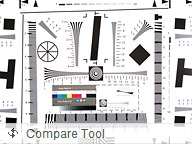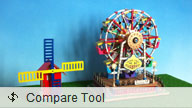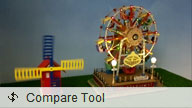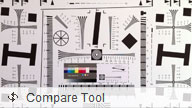HTC Radar review: Mango on the radar
Mango on the radar
Wide-angle camera
The HTC Radar is equipped with a 5 MP autofocus camera with a few tricks under its belt - it utilizes a 28mm wide-angle F2.2 lens and a BSI (back-side illuminated) sensor. The end result is stills of 2560х1920 resolution. It also features a VGA front-facing camera for self-portraits and video calling.
What the fancy camera specs actually mean in real life is that due to the wide-angle lens you'll be able to fit more into the picture than with other phones. The F2.2 aperture number means that the phone's camera can capture images with more light, which coupled with the BSI sensor produces very well-light images even in darker environments. But more on that later.
The camera UI is pretty simple – you have your viewfinder and some controls on the right. From top to bottom they are the still/video camera toggle, second video-call camera toggle, virtual zoom buttons and an extended settings menu. On the left you have an arrow that takes you to the images taken with the camera, alternatively you can do a swipe gesture too.
The camera app on Windows Phone offers very extensive settings, ranging from scenes and effects to white balance, contrast, saturation, sharpness, ISO and more.
Interestingly the camera key will wake the phone with a single press – that is unlock it and start the camera. There's an option that prevents the shutter key from starting the camera if the proximity sensor is triggered (to prevent accidental launches when the phone is in your pocket). This option is off by default.
The HTC Radar's shots turn out bright due to the aperture and BSI sensor but we aren't too happy about the resolved detail it produces. You'll notice clipping in the highlights and a lot of smeared detail due to the noise reduction algorithm. Still if you go as far as 50% zoom the photos look good with nice colors and exposure.
Here go the HTC Radar full-res camera samples. Enjoy!
We also took a macro photo with the HTC Radar. It offers a good macro mode and will give you detailed shots at close up.
Photo quality comparison
The HTC Radar steps up in our photo quality compare tool to meet the likes of the Apple iPhone 4 and the Samsung Galaxy S Plus. The tool's page will give you more information on what to look out for.
Despite its f2.2 lens with BSI sensor the HTC Radar isn't among the leaders in resolved detail and falls way behind the 5 MP iPhone. Against a foe like the Galaxy S Plus it does okay.



The HTC Radar in the Photo Compare Tool
HD video recording disappoints
The video camera interface is identical to the still camera one and has plenty of features too. You can calibrate contrast, saturation and sharpness, change the white balance or exposure compensation and also add image effects. You can use the LED as a video light too.
Your captured videos appear in a thumbnail slideshow just as they do in the Pictures hub and Music & videos hub. You get a flash on/off toggle in the settings menu too - the phone uses the LED as a video light.
The HTC Radar captures 720p videos but doesn't do too well in terms of detail. There's a shamefully low amount of it in the videos we shot. Colors and smoothness turned out fine but we can't help but feel that the HD moniker of the Radar's camcorder is undeserved.
Here's an example of what the HTC Radar's camcorder is capable of.
We've prepared an untouched 720p video sample from the HTC Radar's camera for direct download.
Video quality comparison
We've enrolled the HTC Radar in our video compare tool along the HD-capable iPhone 4 and Galaxy S Plus. You'll notice that the Radar doesn't produce enough fine detail to justify the HD label.



HTC Radar in our Video Compare Tool
Mango brings enhanced connectivity
The HTC Radar has quad-band GSM/GPRS/EDGE support and dual-band 3G with HSPA (14.4Mbps downlink and 5.76Mbps uplink).
The local connectivity is covered by Wi-Fi b/g/n with DLNA and stereo Bluetooth 2.1. Bluetooth is currently limited as to what it can do – there’s no file transfer support, for one.
Syncing with a computer is done with the Zune computer application. It’s the only way to transfer files directly between your computer and your Windows Phone – there's no Mass storage mode, even now with Mango.
You can sync files with Zune over the USB cable and Wi-Fi. There’s a Mac version of available too - Windows Phone 7 Connector. You can check our detailed review of the Zune software here.
Additional SD storage isn't available on Windows Phone so the HTC Radar doesn't offer such an option.
Another syncing option is the cloud. SkyDrive is a free Microsoft service that gives you 25GB of cloud storage. You can even have your photos automatically uploaded as soon as you snap them.
Mango brings Wi-Fi hotspot functionality too. All you need is an active SIM card with a data connection and you're all set.
Internet Explorer mobile does without Flash
The Internet Explorer on Widows Phone was updated to the latest version for the 7.5 update and it improves the user interface.
The URL bar is always visible (but the status bar at the top of the screen is auto-hides, so you don't actually lose any screen real estate) and next to it is the refresh button. You can, of course, bring up the extended settings, which offer a great deal of options.
The URL bar also serves as a search bar, which is a handy shortcut for looking things up if you're not sure which site exactly will do the job.
The browser interface is quite minimalist - you have only the URL bar at the bottom with a reload icon to the left. Swiping the bar upward reveals shortcuts for tabs, recent, favorites, add to favorites, share page, pin to start and settings. The settings menu offers the usual options like location, allow cookies, delete browsing history but it does offer a very neat option to choose a global preference for mobile or desktop site versions.
The browser makes the controls in web pages look just like their equivalents in native apps. So, a web app can look just like a native app with practically no extra effort from the designer.
The six tab ceiling hasn’t been lifted - it's not too bad, but competing OSes don't have such limitations. We were also hoping to see text reflow, but no luck on that either.
What has changed is performance - the new browser relies on hardware graphics acceleration to provide smoother graphics (and video) and animation and the JavaScript engine has been retooled as well.
Microsoft are so confident that they've set up a page specifically for testing the performance of your phone - both JavaScript and graphics. You can find the page here.
Don't be afraid to pit the phone against even a desktop browser - the tests are pretty demanding and if you're not running a recent version of the major desktop browsers, your computer will surely break a sweat.
Reader comments
- Anonymous
- 29 Apr 2021
- fu%
Where can I find the battery. For my phone ....with mouty piece...?
- Anonymous
- 09 Aug 2015
- rrp
I can't use the short codes on my phone
- Lauriej777
- 14 Mar 2015
- 4}Z
My battery will not hold a charge any more, what should I do?



















